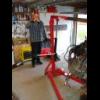In response here to the Ecoat (electrocoat) question, What is it?
Here's a link: http://www.ppg.com/c...es/default.aspx
As with all of these things, the chemistry (epoxy), the coating thickness of the paint, and pre-treatment of the panels (cleaning and zinc phosphating)
all cost money.
I have a few Heritage panels, and I checked last evening
Coating thickness is 15-20 microns of electrocoat (E Coat) on the Heritage panels, doesn't come off with thinners even soaking - so I think it's the epoxy type, that's been baked on.
The original grey epoxy Ecoat on my Mini is 20-22 microns.
Longbridge introduced Ecoating for Minis in the early 90's, replacing the old Rotadip process
Even though E coat has great properties there are a few drawbacks (apart from cost)
1. Epoxy Ecoat degrades under UV light- so needs a top coat to protect it, or keep it dark.
2. Edge coverage (where the sharp bits of the panels are!) isn't great, so some seam sealant to cover the edges keeps the rust away.
3. It doesn't conduct electricity well, once baked, so needs to be cleaned off for welding.
For me and the Heritage panels, its a quick scuff with Scotchbrite- (Improves adhesion) - wipe with thinners-> zinc/etch primer, primer, then topcoat














